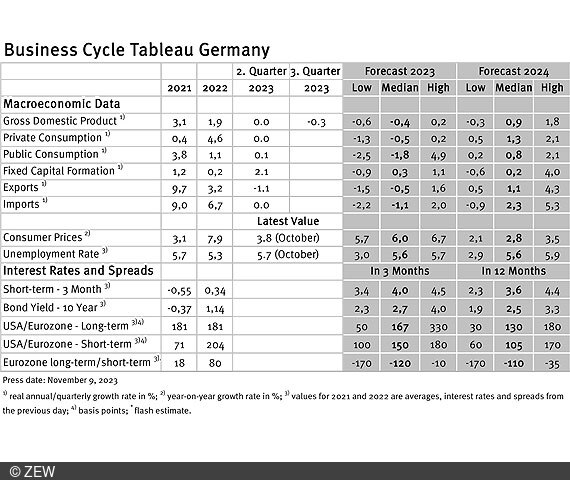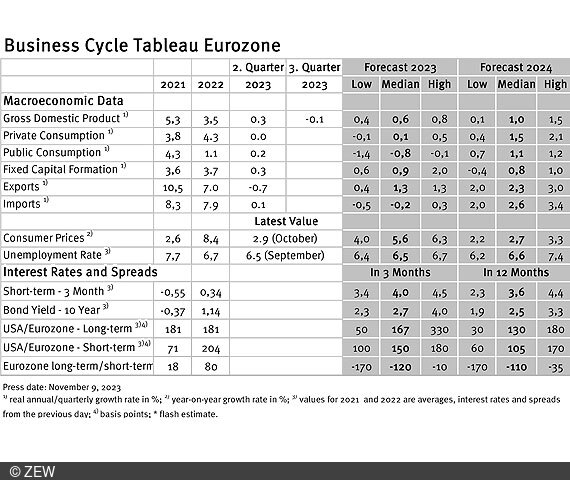Recovery Is a Long Time Coming
Business Cycle Tableaus by ZEW and Börsen-ZeitungWar in the Middle East Not Reflected in Economic Experts’ Forecasts for Now
Business cycle experts anticipate ongoing recession for the German economy. In their outlook for 2024, however, they are somewhat more optimistic than the German Council of Economic Experts, which also recently published its assessment, and see a stronger recovery on the horizon. The easing up of prices is providing positive impetus – the significant drop in inflation should boost private consumption and, along with it, the economy. Therefore, for the time being, the impact of the war in the Middle East is not yet noticeable among growth and inflation expectations. These are the results of the business cycle tableaus by ZEW Mannheim and the German daily newspaper, Börsen-Zeitung.
The quarterly growth figures for Germany’s real gross domestic product (GDP) are given as 0 per cent for the second quarter (unchanged from October) and minus 0.3 per cent for the third quarter. The growth assumptions for Germany have remained the same since October. Furthermore, experts predict a 0.4 per cent drop in the real GDP for 2023, and a 0.9 per cent rise in 2024.
Private consumption and foreign trade will be the main drivers of recovery
While the forecast for 2023 is in line with the recently published assessment of the German Council of Economic Experts, the expected growth rate for 2024 is 0.2 percentage points higher than that of the Council. Thus, economic experts expect a slightly stronger comeback from the German economy. For 2024, particularly high growth rates are expected for private consumption (1.3 per cent), exports (1.1 per cent) and imports (2.3 per cent). These domains are seen as the main drivers on the path to recovery.
Better prospects for the eurozone
The quarterly growth rates for the eurozone are given as 0.3 per cent in the second quarter (unchanged from October) and minus 0.1 per cent in the third quarter. Thus, economic growth in the eurozone continues to somewhat outpace that of Germany. The growth assumptions for the eurozone have hardly changed since October. Although experts have adjusted their growth forecast for 2023 upward by 0.1 percentage points to 0.6 per cent, the growth prospect for 2024 remains at 0.1 per cent.
Inflation rate continues to decline
Inflation rates have noticeably sunk in Germany as well as in the wider eurozone in the last month. In October, inflation stood at 3.8 per cent for Germany and 2.9 per cent for the eurozone. Looking at the entire year, average inflation is expected to be 6.0 per cent for Germany and 5.6 per cent for the eurozone. Experts forecast 2024 inflation rates as 2.8 per cent for Germany, up 0.2 percentage points from October, and 2.7 per cent for the eurozone.
Overall, it seems that the war in the Middle East is not yet reflected in experts’ growth and inflation expectations for Germany and the eurozone. This could also have to do with the fact that the rise in oil prices feared after the outbreak of the conflict did not materialise.
No easing of monetary policy in sight
Monetary policy expectations have remained the stable since October. Expectations for short-term interest rates in the next three months have been adjusted upward by merely 0.1 percentage points. Although the experts expect the inflation rate to fall sharply in 2024, approaching the inflation target, they do not expect monetary policy to ease up for the time being.
Business Cycle Tableaus by ZEW and Börsen-Zeitung
In cooperation with Börsen-Zeitung, ZEW has been publishing monthly business cycle tableaus for Germany and the eurozone with economic key figures and forecasts since 2013. Numerous banks and institutes publish reports on the current and prospective economic situation at different intervals. The information relevant for the tableau is filtered out of these publications to compute a median, minimum and maximum of the available forecasts for the current and subsequent year.
The monthly tableaus show current GDP forecasts, its main components, consumer prices, industrial production, unemployment rate, short- and long-term interest rates, and interest rate spreads. The focus of the tableaus lies on national business cycle reports, which are complemented with forecasts from international banks and institutes. The tableau for the eurozone is enhanced by data from European banks and institutes.

